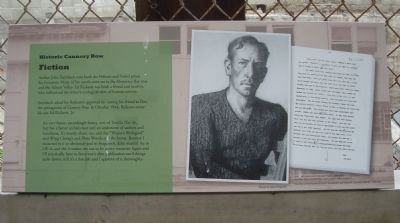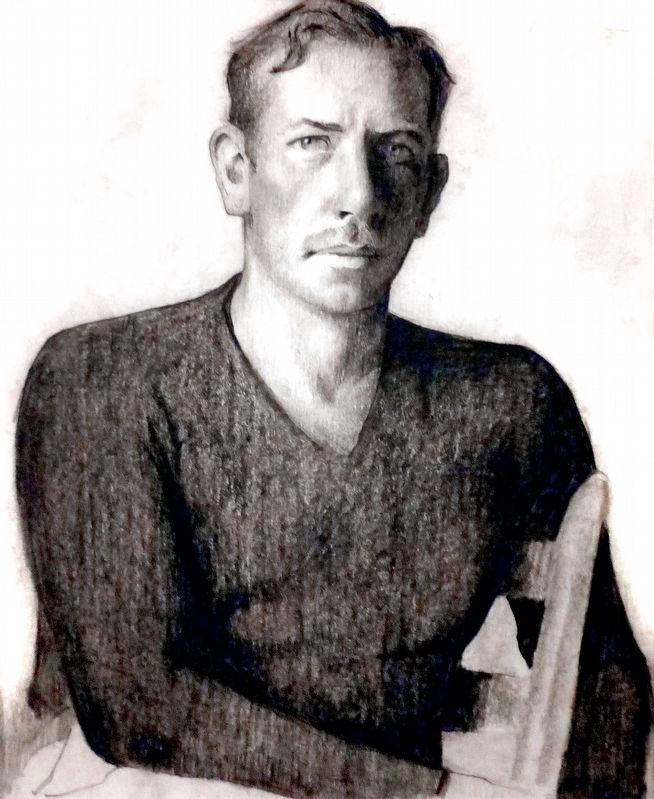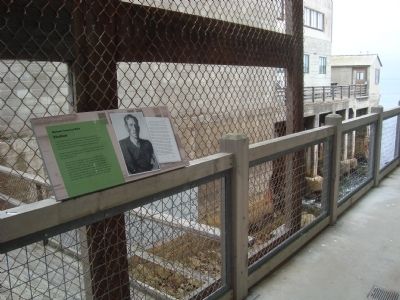Fiction
Historic Cannery Row

Steinbeck asked for Ricketts’s approval for casting his friend as Doc, the protagonist of Cannery Row. In October 1944, Ricketts wrote his son Ed Ricketts, Jr.:
It’s very funny, exceedingly funny, sort of Tortilla Flat-ish, but has a better architecture and has an undertone of sadness and loneliness. It’s mostly about me, and the “Western Biological” and Wing Chong’s and Flora Woods and the bums. Because I occurred in it so obviously and so frequently, John wanted me to OK it, and tho it makes me out to be a very romantic figure and I’ll practically have to leave town after publication until things quiet down, still it’s a fine job and I approve of it thoroughly.
Topics. This historical marker is listed in this topic list: Arts, Letters, Music. A significant historical month for this entry is October 1944.
Location. 36° 37.041′ N, 121° 54.055′ W. Marker is in Monterey, California, in Monterey County. Marker can be reached from Cannery Row. This marker is located on a small alleyway to the right of Ed Ricketts’s Pacific Biological Laboratories
Other nearby markers. At least 8 other markers are within walking distance of this marker. Science (a few steps from this marker); Ed Ricketts’s Backyard (a few steps from this marker); The Real “Docs” (within shouting distance of this marker); One Man, Two Worlds (within shouting distance of this marker); A Day in the Canneries (within shouting distance of this marker); The Spanish Community (within shouting distance of this marker); The Del Mar Canning Company, 1927-1947 (within shouting distance of this marker); The Japanese Community (within shouting distance of this marker). Touch for a list and map of all markers in Monterey.

"Although he was a great contributor to American literature, John Steinbeck retreated from fame. This portrait of the author by James Fitzgerald was executed in 1935, the same year that Steinbeck's first commercially successful novel, Tortilla Flat, was published. Steinbeck claimed to be 'scared to death of popularity,' saying 'it has ruined everyone I know.' In the 1930s and 1940s, both Steinbeck and Fitzgerald belonged to a loosely organized group of artists, writers, and intellectuals in Monterey, California. Although they often argued violently, both men respected each other's talent and shied away from public recognition. Steinbeck's famed novels Of Mice and Men (1937) and The Grapes of Wrath (1939) earned him even more acclaim, and he was awarded the Nobel Prize in Literature in 1962. Fitzgerald expresses Steinbeck's reclusive personality by casting half of the author's face in dark shadow." -- National Portrait Gallery
Credits. This page was last revised on May 5, 2021. It was originally submitted on May 8, 2012, by Barry Swackhamer of Brentwood, California. This page has been viewed 627 times since then and 35 times this year. Photos: 1, 2. submitted on May 8, 2012, by Barry Swackhamer of Brentwood, California. 3. submitted on August 20, 2018, by Allen C. Browne of Silver Spring, Maryland. 4. submitted on May 8, 2012, by Barry Swackhamer of Brentwood, California. • Bill Pfingsten was the editor who published this page.

